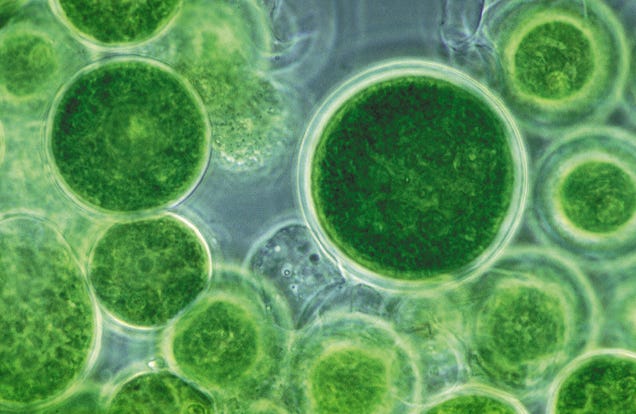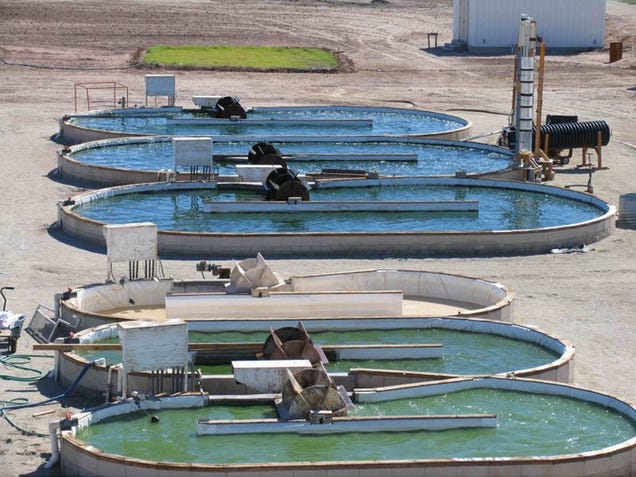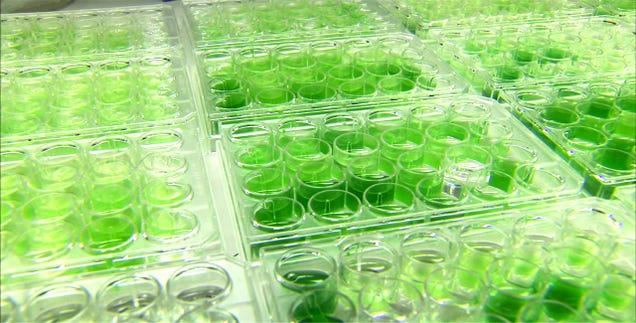
Earth Protect Blog
- Font size: Larger Smaller
- Hits: 4515
- 0 Comments
The Future Will Run On Algae

In the twentieth century, oil was black gold. But as we march deeper into the twenty-first century, we could have a lucrative new fuel on our hands. One that’s blue-green and sometimes a little smelly. It’s found in wastewater, but it’s capable of powering jets. It’s algae.
How It Works
To be specific, it’s actually microalgae. Though it looks like green scum or strands of hair floating on the water, microalgae is actually made up of microscopic, single-celled organisms capable of photosynthesis, like plants. They slurp in sunlight, and convert it to energy. They’re also able to suck up carbon dioxide emitted by power plants and cars, turning it into oxygen. So they run on solar power and they scrub the air, both of which are very appealing qualities for a post-oil world.
But the real lure of microalgae is its ability to produce fuel. Some of these minuscule, aquatic microorganisms produce oils to store energy. Scientists can convert that oil into fuel for cars, trucks, trains, and planes. This is better for the environment than fossil fuels, because it’s carbon neutral: The plants draw down as much carbon as they put out. Plus, algae is a renewable resource, meaning we can make more and more of it forever.
The whole system is so efficient that the US Department of Energy says algae fuels could be running any machine that’s dependent on diesel today.
And this isn’t some scifi, pie-in-the-sky fuel source that we hope to have someday. It’s already here. Back in 2011, United Airlines made history with the first algae-powered passenger flight from Chicago to Houston.
Japan is also pursuing algae as a biofuel source. A company called Euglena Co. — named by Prime Minister Shinzo Abe has his “favorite startup” — has partnered with Isuzu Motors to produce a fleet of ecofriendly buses that run on microalgae. They also plan to fuel a commercial flight of their own using only algae biofuel by the 2020 Olympic Games in Tokyo.
Here in the US, scientists have been researching algal biofuels since the late 1970s, but it’s only been in the last six years or so that funding from places like the Department of Energy has kicked back up again. Why the sudden interest? Because there’s no arguing with the benefits.
Why It’s Great
Because of its energy-producing properties, and because of the fact that algae grow quickly (doubling their number in a matter of hours), researchers want to harness it for a greater good.
“We are aiming to commercialize in the near future,” says Naoto Mukunoki, a spokesperson for Euglena. “The fuel derived from euglena is very light, and doesn’t harden in the sky’s low temperature. This is the same characteristic of kerosene, or existing jet fuel.” Which could make carbon-spraying planes way less harmful for the environment. Another plus: You can also grow algae in places where you couldn’t grow anything else, like brackish waters or wastewater.
Algae growing ponds at UC San Diego
We could even stick algae ponds next to power plants that release carbon dioxide into the air, using their C02 emissions to power those algae ponds. Did I mention it’s homegrown? There’s no import cost, so we can save money and improve the environment right here at home.
It’s even got an edge over other biofuels. Take corn-based ethanols, for example. While those veggie-derived ethanols can already power vehicles, the Department of Energy says that microalgae could produce up to 60 times more oil per acre than plants grown on land. The DoE also says some researchers pin algae’s potential productivity as anywhere from 10 to 100 times higher than biofuels made from feedstocks.
But hold on there, friends. Before you start scraping the sides of your filthy goldfish tank hoping to solve the world’s energy crisis, there are some things you need to know.
Why It’s a Pain in the Ass
So, what’s the hold up? Why isn’t verdant pond scum powering all of our cars yet? The science is mature. But you can probably guess the roadblock: it’s the other kind of green. The evil one. That dolla dolla bill.
Right now, mass-producing microalgae whose oils we can harness as biofuels is prohibitively expensive. That’s why scientists are trying to figure out ways to get the most bang for your buck. They’re looking for the types of algae that can withstand environmental stresses and produce a lot of fuel-replacing oil.
But therein lies another problem. Not just any algae will power a Dreamliner. Scientists look for those super algaes in a process called “strain identification.” Once we figure out how to produce more of those specific algae strain quickly and on a large scale, that’ll be a huge leap toward commercialization.
Alison Goss Eng is a program manager at the Department of Energy’s Bioenergy Technologies Office. She says that their goal is to get algae fuel costs to around $3 a gallon. “[It’s] something that we think would be competitive with gasoline,” she says. “In the next couple of decades, we could get algae-based fuels to that level. A lot of that has to do with getting the algae to be really productive. We need to get yields up really high.”
Algae from Susan Golden’s lab at UC San Diego
To do this, the researchers take the selected strain and genetically modify it. They change its environment and run it through stress tests, forcing it to produce as much oil as possible. This is called “strain improvement,” and it helps the team figure out which conditions render the most plentiful and powerful masses of algae. What’s the water temperature? What’s the right amount of light?
These tests give scientists a better idea of how to maximize costs and grow the strongest algae the fastest. They’re doing this in both open ponds and what are called “photobiotic reactors”: closed tubes or plastic bags with algae growing inside.
“Converting [the oils to fuel] is really expensive,” Eng says. So her team is partnering with algae-focused businesses and research institutions to research the best ways to get the most out of those algae strain. Crack the algae’s code, and we could crack our energy problems.
What the Future Holds
Algae isn’t just a potential wonder fuel, however. It also has uses in skin care products, omega 3-rich baby formula, livestock feed, chemical processing … and endless other possibilities.
And we really mean “endless.” Even surfboards made out of algae are a thing, like the one announced in April by researchers at the University of California, San Diego. You see, fossil fuels find their way into surfboards (and a lot of other stuff) via polyurethane foam. But using algal oils actually improves the surf board’s performance by making it more flexible — and, more importantly, it eliminated the need to use unsustainable fossil fuels. Algae even lets usbuild flexible robots that move in a more human-like way.
But before we can start pumping everyday objects full of sustainable, magical algae oils, we need to drive the price of production down. That’s researchers’ biggest obstacle right now.
Eng says the algae industry is gunning for “aggressive productivity” in the next 10 to 20 years. In the nearer term, the Department of Energy is aiming to get algae-per-acre production up to 5,000 gallons by 2022. Not an easy task, and not a cheap one.
However, once an emerging technology gets the greenlight from presidents, prime ministers, major universities, and billion-dollar airline conglomerates—which algae already has—progress can only go forward.
It’s not easy being green, but damn, will it pay off in the end.
Comments
-
Please login first in order for you to submit comments
















